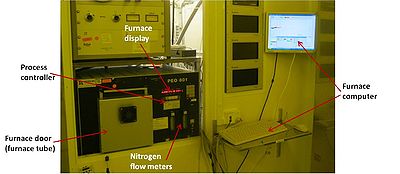Specific Process Knowledge/Thermal Process/Resist Pyrolysis Furnace: Difference between revisions
(Created page with " ==This page is under constrution== == Resist Pyrolysis Furnace == The Resist Pyrolysis Furnace is used for resist pyrolysis, where samples with different resist layers are...") |
No edit summary |
||
| Line 6: | Line 6: | ||
The Resist Pyrolysis Furnace is used for resist pyrolysis, where samples with different resist layers are heated up to maximum 1000°C in a nitrogen atmosphere. At high temperatures carbon is formed by pyrolysis of the resist. In this way conductive structures can be made from a resist patterned sample. | The Resist Pyrolysis Furnace is used for resist pyrolysis, where samples with different resist layers are heated up to maximum 1000°C in a nitrogen atmosphere. At high temperatures carbon is formed by pyrolysis of the resist. In this way conductive structures can be made from a resist patterned sample. | ||
If oxygen from the air or from outgassing of the resist is present in the furnace, the resist layer will be removed. Thus, for each process it is important to include a step with a high nitrogen flow at a lower temperature, before a high temperature for resist pyrolysis is obtained. Pyrolysis of a large amount of resist may also be a problem due to resist outgassing. | |||
During processing the furnace is rapidly heated by use of six long heating lamps situated around the furnace tube, andt cooling is done (rather slowly) by use of cooling fans. The furnace is purged with a controlable nitrogen flow. There is no vacuum on the furnace. | |||
'''The user manual, user APV, technical information and contact information can be found in LabManager:''' | '''The user manual, user APV, technical information and contact information can be found in LabManager:''' | ||
[[image: | [[image:Resist_Pyrolysis_Furnace.jpg|400x400px|right|thumb|The Resist Pyrolysis furnace. Located in the III-V Lab]] | ||
[http://www.labmanager.danchip.dtu.dk/function.php?module=Machine&view=view&mach=294 Resist Pyrolysis Furnace] | [http://www.labmanager.danchip.dtu.dk/function.php?module=Machine&view=view&mach=294 Resist Pyrolysis Furnace] | ||
| Line 15: | Line 19: | ||
== Process information == | == Process information == | ||
There are no standard processes on the furnace. | |||
==Equipment performance and process related parameters== | ==Equipment performance and process related parameters== | ||
| Line 31: | Line 25: | ||
{| border="2" cellspacing="0" cellpadding="2" | {| border="2" cellspacing="0" cellpadding="2" | ||
!colspan="2" border="none" style="background:silver; color:black;" align="center"| | !colspan="2" border="none" style="background:silver; color:black;" align="center"|Resist Pyrolysis Furnace | ||
|style="background:WhiteSmoke; color:black"|<b>Equipment 1</b> | |style="background:WhiteSmoke; color:black"|<b>Equipment 1</b> | ||
|- | |- | ||
!style="background:silver; color:black;" align="center"|Purpose | !style="background:silver; color:black;" align="center"|Purpose | ||
|style="background:LightGrey; color:black"| | |style="background:LightGrey; color:black"| | ||
|style="background:WhiteSmoke; color:black"| | |style="background:WhiteSmoke; color:black"| | ||
* | *Pyrolysis of different resist layers to form conductive structures | ||
|- | |- | ||
!style="background:silver; color:black" align="center" valign="center" rowspan="2"|Process parameter range | !style="background:silver; color:black" align="center" valign="center" rowspan="2"|Process parameter range | ||
|style="background:LightGrey; color:black"| | |style="background:LightGrey; color:black"|Temperature | ||
|style="background:WhiteSmoke; color:black"| | |style="background:WhiteSmoke; color:black"| | ||
* | *0-1000 C | ||
*Temperature ramp-up rate: Max 10 C/min | |||
*Temperature ramp-down rate: Relative slow (depending on the furnace temperature) | |||
|- | |- | ||
|style="background:LightGrey; color:black"| | |style="background:LightGrey; color:black"|Nitrogen flows | ||
|style="background:WhiteSmoke; color:black"| | |style="background:WhiteSmoke; color:black"| | ||
* | *Flow 1: Max 660 liter/hour | ||
*Flow 2: Max 3500 liter/hour | |||
|- | |- | ||
!style="background:silver; color:black" align="center" valign="center" rowspan="3"|Substrates | !style="background:silver; color:black" align="center" valign="center" rowspan="3"|Substrates | ||
| Line 81: | Line 52: | ||
*<nowiki>#</nowiki> 100 mm wafers | *<nowiki>#</nowiki> 100 mm wafers | ||
*<nowiki>#</nowiki> 150 mm wafers | *<nowiki>#</nowiki> 150 mm wafers | ||
|- | |- | ||
| style="background:LightGrey; color:black"|Allowed materials | | style="background:LightGrey; color:black"|Allowed materials | ||
| Line 91: | Line 57: | ||
*Allowed material 1 | *Allowed material 1 | ||
*Allowed material 2 | *Allowed material 2 | ||
|- | |- | ||
|} | |} | ||
Revision as of 15:25, 30 November 2012
This page is under constrution
Resist Pyrolysis Furnace
The Resist Pyrolysis Furnace is used for resist pyrolysis, where samples with different resist layers are heated up to maximum 1000°C in a nitrogen atmosphere. At high temperatures carbon is formed by pyrolysis of the resist. In this way conductive structures can be made from a resist patterned sample.
If oxygen from the air or from outgassing of the resist is present in the furnace, the resist layer will be removed. Thus, for each process it is important to include a step with a high nitrogen flow at a lower temperature, before a high temperature for resist pyrolysis is obtained. Pyrolysis of a large amount of resist may also be a problem due to resist outgassing.
During processing the furnace is rapidly heated by use of six long heating lamps situated around the furnace tube, andt cooling is done (rather slowly) by use of cooling fans. The furnace is purged with a controlable nitrogen flow. There is no vacuum on the furnace.
The user manual, user APV, technical information and contact information can be found in LabManager:
Process information
There are no standard processes on the furnace.
| Resist Pyrolysis Furnace | Equipment 1 | |
|---|---|---|
| Purpose |
| |
| Process parameter range | Temperature |
|
| Nitrogen flows |
| |
| Substrates | Batch size |
|
| Allowed materials |
| |
